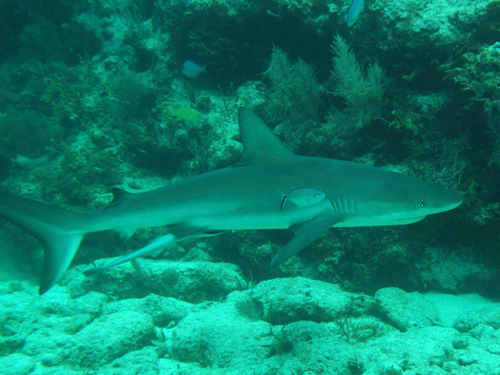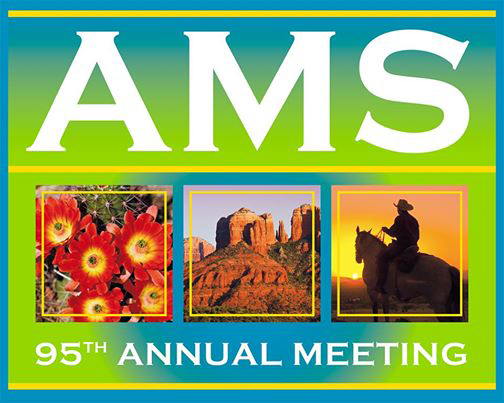The 95th AMS Annual Meeting in Phoenix begins this weekend. Are you concerned that you won’t be able to keep track of everything going on at the meeting? Do you want to be certain that you don’t miss any presentations, exhibits, or special events? Are you looking for some help with organizing all of your plans for Phoenix? We have a solution for you: the AMS 2015 mobile app! 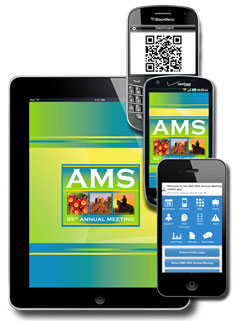 On it you can find lists of exhibitors, sessions, Town Hall Meetings, and even individual authors making presentations. With the app, you can access helpful documents (including maps of the Phoenix Convention Center), keep up with social media activity, watch videos from the meeting, and get shopping, dining, and entertainment suggestions for the Phoenix area. There’s even a “locate me” feature in case you get lost in the convention center–which could be a common occurrence with so much going on!
On it you can find lists of exhibitors, sessions, Town Hall Meetings, and even individual authors making presentations. With the app, you can access helpful documents (including maps of the Phoenix Convention Center), keep up with social media activity, watch videos from the meeting, and get shopping, dining, and entertainment suggestions for the Phoenix area. There’s even a “locate me” feature in case you get lost in the convention center–which could be a common occurrence with so much going on!
The app will also provide real-time alerts and information from the meeting’s organizers. And maybe best of all, it includes a personal scheduler that allows you to keep track of your day-to-day plans so that you don’t miss anything.
You can do all of this with just a few clicks on your mobile device, whether it’s an iPhone or iPad, Android device, or Blackberry or Windows phone. And it’s free! So what are you waiting for? Download the app today by visiting this page (and get some tips for using the app here).
 Matt
Matt
In the Wake of Shark Week…
By Anupa Asokan, AMS Education Program
For many of us who have dedicated our lives to studying, protecting, and loving the ocean, Jaws and Shark Week are two of the primary reasons why. I always look forward to that wonderful week in August where I can be guaranteed endless hours of the deep blue and beautiful toothy creatures. And Jaws . . .what else can I say but: “amazing!” So why do some of us find these pieces of sensationalism inspiring, while others cite them as a reason to fear the ocean? The short answer is: those of us who know, know better.
Most of the events and creatures that become the subject of horror movies and sensationalism are far-fetched and/or products of the human imagination. Deep down we all know that we’re not going to encounter a zombie walking down the street. The ocean, on the other hand, is already a much less familiar environment, and sharks are very real. We tend to fear the unknown, and if all I knew of the ocean was shark week, I’d be scared too. A swim in the ocean could very well lead to an encounter with a shark. But just as we’ve all walked the streets sans a zombie attack, many of us have also had countless swims/dives/snorkels/surfs/paddles and returned to shore unscathed. I’m not saying a face-to-face encounter with the Landlord (aka the great white shark) wouldn’t make me shake in my wetsuit, but the truth is that more shark attacks don’t happen than do happen.
According to the International Shark Attack File, there have been 767 documented shark attacks since 1580. These are unprovoked bites only (because if you mess with something that doesn’t have hands to fight back, I think you’re asking to get bit). Less than 20% of these bites were fatal. Let’s put this in perspective, shall we? I will round up, and that is still only an average of 2 bites a year. Which means you are 23 times more likely to die from a lightning strike, 136 times more likely to die from sun/heat exposure, and almost 30,000 times more likely to die of the flu. I can even make this more fun. More people also die each year from falling coconuts, vending machines, falling airplane parts, and playing soccer in England. Few–if any–of us are afraid of sunshine, tropical plants, or snacks, but sharks unfortunately have acquired a very bad reputation.
Yes, sharks are stellar hunters. They’ve had over 400 million years to perfect their predator status in the ocean. Yes, sometimes they get confused and think humans are delicious, blubbery seals, but they’re definitely not prowling the seas looking for people to snack on. They are truly amazing creatures that are a crucial part of a delicate and intricate food web, and they’re in trouble. Their numbers are declining so rapidly that I feel fortunate to have had any encounters whatsoever with these beautiful animals.
So to all the meteorologists out there, take this as a cautionary tale from us marine scientists. Twister could very well be your Jaws and Tornado Week would be a great tribute on The Weather Channel to an incredible phenomenon (oh wait, it already exists!). Let’s not let the world panic at the sight of every cloud in the sky. Let’s put people in the know. Let’s be powerful educators and effectively preempt the fear-mongering.
The Annual Meeting Is Closer than You Think!
The 2015 AMS Annual Meeting in Phoenix is less than six months away. AMS President Bill Gail and 2015 Annual Meeting Organizing Committee chairs Andrea Bleistein, Andrew Molthan, and Wendy Schreiber-Abshire recently sent out this reminder that the deadline for submitting abstracts for the meeting is fast approaching:
Have you submitted your abstract for AMS 2015 yet?
Yes? Then you know that we’ve got something for everyone with over 30 conferences and symposia featuring almost 300 topics!
No? Don’t worry–there’s still time to submit your abstract before the deadline of 1 August!
This year’s theme is: Fulfilling the Vision of Weather, Water, and Climate Information for Every Need, Time, and Place
View the Call for Papers here: http://annual.ametsoc.org/2015/index.cfm/call-for-papers/
Submit your abstract online here: https://ams.confex.com/ams/95Annual/oasys.epl
Even if you don’t plan to present in Phoenix, we hope you make plans to join us in January. Check out our website to learn more about all the exciting things going on at AMS 2015!
We can’t wait to read your submission and look forward to your participation,
Bill Gail, AMS President
and
Andrea Bleistein, Andrew Molthan, and Wendy Schreiber-Abshire
2015 Annual Meeting Organizing Committee Chairpersons
Every Day Can Be World Oceans Day
by Anupa Asokan, AMS Education Program
Most of us recognize that the ocean is a driving force behind our weather and climate, but it is so much more than that. Comprising the majority of our planet, this environment was once thought to be limitless and infallible. While much of our hydrosphere remains to be explored, we’re quickly learning how vulnerable this chunk of our planet really is. Issues like ocean acidification and marine debris may pop up in our news feeds every now and then, but our daily activities have significant implications as to the health of this global ecosystem we rely upon for oxygen, food, transportation, and recreation, to name a few.
Working as a marine science educator in an outdoor setting, I was fortunate enough to share my love of this wonderful environment with children from all over the country. For many coming from inner-city schools or midwestern states, this snorkeling adventure would be their first and perhaps only encounter with the ocean. The goal in creating this positive ocean experience wasn’t just a cool story to tell mom and dad back home, but to instill a connection and sense of ownership for this fragile environment. At the AMS Education Program, we might not have the opportunity to put students first-hand into a kelp forest or coral reef, but we do provide teachers with the tools they need to bring the lessons these environments bear directly to the classroom. It seems odd to compare snorkeling through a kelp forest to teaching a teacher the fundamentals of oceanography, but the key here is awareness. Whatever the approach, ocean literacy can be a powerful a tool, because knowing is, after all, half the battle.
In a more global effort to encourage just that, World Oceans Day was born. Sunday, June 8th marked the 12th year of this worldwide ocean celebration. Like Earth Day every April, this annual event is intended to create awareness and hopefully encourage stewardship for the environment. This year, thousands of organizations in 70 countries arranged events to honor the ocean. From beach cleanups to film festivals to paddle-board races, there were opportunities to participate in just about every corner of the globe. For those without a local event, social media offered another avenue to join in with ocean selfies and photo contests. Many events even extend through the entire month of June, and you may also find regularly scheduled events occurring throughout the year. Even if you don’t live near water, there are some simple things we can all do to celebrate and protect the ocean year-round:
- Pick up trash and use less plastic
- Make responsible seafood choices
- Watch what you put down your drain
- Join or volunteer with a conservation organization
As a SCUBA diver, avid snorkeler, and lover of all things ocean, I’ve spent a lot of time enjoying everything that it has to offer. Whether you share my passion or are terrified of the deep blue, live near a coast or are landlocked, none of us lives a life the ocean hasn’t impacted. So let’s all give a little something back to Mama Ocean, not just on June 8th, but perhaps the other 364 days of the year, too.
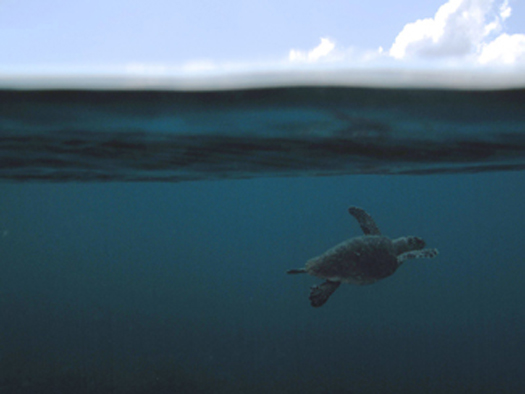
STEM Education: Looking Back and Looking Ahead
by Tom Champoux, AMS Director of Communications
When I was in the fourth and fifth grade, my father visited my class on Science Day a number of times. I remember his visits vividly because he would always bring unique and interesting items with him–things no one else’s dad brought, like weather maps and rock samples. He once even brought in a grainy, amateur film that showed the volcanic island Surtsey being born off the coast of Iceland in the mid-1960s.
I also went with him many times to work, hanging out in his office while he taught class. There, my siblings and I would always find some interesting science toy or activity to play with and learn from. It was during these years that I learned so much about Earth and space science, and it served as the foundation for my love of science that has lasted a lifetime.
Officially my father was an Earth science and geology professor at a small community college in northern Massachusetts, but he also taught meteorology, and later even added algebra and computers.
This week, AMS released a new policy statement on STEM education (Science, Technology, Engineering, and Mathematics), and reading through it I was reminded of my exposure to science in grade school. I was reminded too of the power of science to excite and engage school children in ways other subjects can’t.
In the new AMS Policy Statement, AMS supports maintaining Earth systems science as an integral part of STEM education–both to provide all students with a basic understanding of the Earth system as well as to create a pipeline of students who will become America’s future scientists and researchers.
The Earth system affects all of us, every day–from severe weather to rising seas, from solar radiation to plate tectonics. Because so much of what we experience every day is part of a very large and complex system, it is critical that all students learn about that system and the relationship between all areas of Earth science.
Most scientists can vividly recall the time or even the moment when they fell in love with science. Like me, many were school-age when it happened. There’s an inherent excitement in science–in looking through a telescope or microscope for the first time, or in creating models of volcanoes or posters showing the lifecycle of common frogs. Children want to understand science and engage in it, and it’s vitally important that we provide every opportunity to do just that.
Tomorrow’s challenges in understanding and explaining water, weather, and climate will be solved by today’s students. And those scientists of tomorrow will need their peers to be a receptive and knowledgeable public capable of utilizing science to solve society’s challenges. Providing all students with the best possible understanding of how the Earth works, and how humans function on it, will be vitally important to people everywhere.
What Does It Mean to Be Meteorological?
by Anupa Asokan, AMS Education Program
From my past life as an educator, I’m used to misconceptions. In fact, I welcome them as an opportunity for a more impactful “teachable moment.” In the outdoor setting where I once taught marine science, this was usually centered around sharks, which thanks to sensationalist media and works of art like Jaws, I often had the opportunity to spout out some random fact about how you are more likely to die from a falling coconut and hopefully allay the fears of every child forced to listen to me. Now, working with the AMS Education Program, my teachable moments are focused less on sharks and much more on the word “meteorology.”
My first encounter with the word was as a young child watching my local TV meteorologist. Every evening, Bill Quinlan would tell me about the weather. I vividly remember being in awe of the fact that he would be focused on something out in the ether and yet somehow knowingly point at the correct spot on that magical, wondrous, colorful map behind him. If you, a fellow nerd of all things weather, are reading this, you probably have a similar account from your childhood, but as it turns out, the association between meteorology and the weather isn’t something that every person stumbles upon in their lifetime.
Representing the AMS at various conferences and events, I’ve been shown many alleged “meteorites” from people hoping to confirm the extraterrestrial origin of their favorite rock. Most recently, the AMS Education Program participated in the Science and Engineering Festival in Washington, D.C., last month. This is a truly amazing production and a dream come true for teachers and lovers of science alike, and we were offering a fun, weather-inspired activity: making clouds in a bottle.
The exhibits were separated into sections by topic. The Earth science section had a cool graphic of a cloud, rain, and a lightning bolt. . . but for some reason it didn’t have us. Instead, we were in the space section–“Astronomy and Space Exploration,” to be exact, represented by a picture of a little rocket. Now don’t get me wrong, it is always cool to be near NASA, but where does this disconnect between meteorology and the weather come from? Certainly, the “meteor” in meteorology has always caused some confusion, and you could say we “fit” in space—forecasting technology and space weather have roots in the study of the atmosphere. On the other hand, meteorology exists if not to tell us the impact of the atmosphere on our day-to-day lives here on Earth.
So there we were, set up in “space” with our bottles and aerosols, ready to create some clouds and conveniently provided with the perfect teachable moment for 325,000 visitors to Science Fest. That is why we were there, after all, because who else is going to teach the world what meteorology really is, but those of us who love everything that it represents, Earthly or otherwise.
Buy This Book and Save the Planet
Saving the planet is a cooperative effort, says William Hooke of the AMS Policy Program. It will also take some humility, scientific savvy, a willingness to act on limited information, and an understanding of when to approximate and when to be precise. It also means dealing with a world of chaos–in short, it means thinking like a meteorologist. Hence, Hooke’s newly released AMS book, Living on the Real World: How Thinking and Acting Like Meteorologists Will Help Save the Planet. 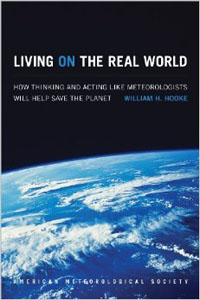
“It’s very easy in management to think that what you’re doing doesn’t matter very much,” he says. But, like the atmosphere, the slightest fluctuations have a significant impact and managers in science should consider Lorenz’s butterfly effect. “The littlest thing that I do has ripple effects that expand out and change the world forever,” he says. “That’s an important thing for every one of seven billion people to embrace. Otherwise, we feel we get lost, we’re insignificant in the scheme of things.”
Hooke sat down with BAMS Editor in Chief Jeff Rosenfeld to discuss the book and the importance of collaboration in meteorological research and even management; the whole interview can be found here. Stop by to meet Bill and get a copy of Living on the Real World at the book signing event at the AMS Resource Center in the Exhibit Hall during this afternoon’s poster session, 2:30 PM – 4 PM. Copies are limited, so it’s first-come, first-served, but the book will be released soon and available at the AMS Bookstore.
AMS Book Takes ASLI Awards by Storm
Wednesday afternoon, AMS Books will take a bow. Taken by Storm 1938: A Social and Meteorological History of the Great New England Hurricane, authored by Lourdes B. Avilés and published by the AMS, will receive an ASLI Choice Award in the historical category. 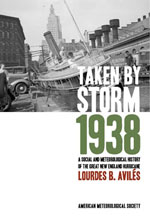 The book, which documents both the science of the storm and its social impacts, was recognized by ASLI for “its comprehensive account of this major storm, from its inception to aftermath.” (You can learn more about the book and see an interview with Avilés here.)
The book, which documents both the science of the storm and its social impacts, was recognized by ASLI for “its comprehensive account of this major storm, from its inception to aftermath.” (You can learn more about the book and see an interview with Avilés here.)
The winning title in the science and technology category is Mathematics and Climate, by Hans Kaper and Hans Engler, published by the Society for Industrial and Applied Mathematics. ASLI lauded the book for “its accessible explanations in key areas where climate and mathematics meet.” 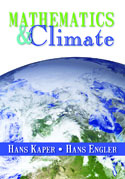 There was also an honorable mention in the historical category: Probing the Sky with Radio Waves: From Wireless Technology to the Development of Atmospheric Science, by Chen-Pang Yeang, published by the University of Chicago Press, selected for “its very thorough, technical history of radio waves and their importance to ionospheric science.”
There was also an honorable mention in the historical category: Probing the Sky with Radio Waves: From Wireless Technology to the Development of Atmospheric Science, by Chen-Pang Yeang, published by the University of Chicago Press, selected for “its very thorough, technical history of radio waves and their importance to ionospheric science.”
This is the ninth year that Atmospheric Science Librarians International has recognized the best books in in the fields of meteorology/climatology/atmospheric sciences. The award presentation will take place Wednesday at 4:45 at the ASLI booth (#732) in the Exhibit Hall, and before that, from 2:45 to 4:00, Avilés will be signing her book at the AMS Resource Center in the Exhibit Hall. Stop by, meet the author, and purchase a copy of her award-winning book!
Atlanta Roads Lead to Annual Meeting Theme
As society urbanizes, weather impacts are exacerbated in sometimes-unfamiliar ways. Case in point: the snow, ice, and cold that paralyzed much of the southeastern United States this week. More specifically–and more germane to AMS members attending this year’s AMS Annual Meeting–delays caused by gridlock in Atlanta were being measured in days, not hours, and thousands of people were stranded in schools, stores, their cars, and other places that weren’t their homes.
The timing of this unfortunate event is appropriate, given the Annual Meeting’s theme of “Extreme Weather–Climate and the Built Environment: New Perspectives, Opportunities, and Tools.” Even before this week’s events, the meeting was going to be buzzing with discussions about all aspects of weather and climate impacts in urban areas. In the wake of events of this week, that buzz may turn into a roar.
One topic certain to elicit a storm of interest is road transportation–the most visible of the vital, weather-prone infrastructure systems in any urban area. At the Ninth Symposium on Policy and Socio-Economic Research, a session on Wednesday (4:00-5:30 PM, Room C107) titled “Observing Weather and Environment along the Nation’s Transportation Corridors” will feature a look at weather-observation sensors for cars, which offer “the potential of turning vehicles into moving weather stations to fill road weather observation gaps.” An equally salient presentation in that session will explore best practices for getting timely and accurate weather and climate information to transportation decision makers.
The 30th Conference on Environmental Information Processing Technologies will include a session on “Road Weather Applications” (Monday, 1:30-2:30 PM, Room C105). One talk will explore the Maintenance Decision Support System, which “blends existing road and weather data sources with numerical weather and road condition models in order to provide information on the diagnostic and prognostic state of the atmosphere and roadway.” Another presentation will analyze driver awareness during two 2013 winter storms in Utah to examine ways to improve communication of hazard information to the public.
The Second Symposium on Building a Weather-Ready Nation will have a session on “Innovative Partnerships in Public Outreach and Decision Support Services” (Tuesday, 3:30-5:30 PM, Georgia Ballroom 2). Included in that session will be an exploration of how the NWS and Federal Highway Administration are collaborating to improve communication and data sharing before, during, and after weather events that have a significant impact on transportation, public behavior, and emergency response. Another talk will take a broader view by examining ways to enhance nationwide environmental education and create a more weather-ready nation–a goal that this week’s events make clear remains of vital import.
Earth Interactions Continues AMS Journals' Movement to Open Access
For almost 20 years, the electronic journal Earth Interactions (EI) has been publishing interdisciplinary research pertaining to the interactions between the lithosphere, hydrosphere, atmosphere, and biosphere in the context of global issues or global change. The diversity of EI‘s subject matter can by seen by perusing a list of its titles; a few recent examples include:
Case Studies of Tropical Cyclones and Phytoplankton Blooms over Atlantic and Pacific Regions
Effects of Topography on Assessing Wind Farm Impacts Using MODIS Data
A Spatially Distributed Model to Simulate Water, Energy, and Vegetation Dynamics Using Information from Regional Climate Models
The Ancient Blue Oak Woodlands of California: Longevity and Hydroclimatic History
The Influence of Loop Current Position on Winter Sea Surface Temperatures in the Florida Straits.
A joint publication of the AMS, the American Geophysical Union, and the Association of American Geographers, Earth Interactions has recently made some significant changes. While the journal will continue to be produced by all three organizations, as of January 1 the AMS has assumed all editorial responsibilities for it, from the submission process through to its publication. EI will set a flat publication fee of $1,200 for every article accepted for publication, with partial or full page-charge waivers available for those with funding limitations. And EI is now an open-access journal, meaning that all articles–past, present, and future–are available free of charge to all readers. This continues the Society’s commitment to providing widespread access to research published in AMS journals; research articles in the Bulletin are also completely open-access, and all other AMS journals provide open access to articles that are more than two years old.
EI was an early leader in making interdisciplinary research the focus of the journal, and providing open access to its articles is another example of the innovative spirit with which the journal is produced. The AMS and its publication partners hope these changes will help disseminate Earth Interactions research to the broadest possible audience, as well maximize the influence and impact of the journal. We invite readers to explore EI here, and authors can submit a manuscript by choosing the Earth Interactions link at this page.
